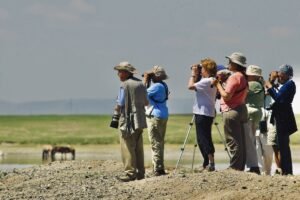World tourism in 2011 and 2012
REPORT – ITB BERLIN 2012 – BERLIN: The world economy is growing, and tourism continues to be one of the strongest elements in that growth, as it has usually been for about half a century. The International Monetary Fund (IMF) estimates that world GDP increased by 5.2% in 2011 – a very substantial margin over the 1.1% increase in the world population.
In an uncertain world…
Does anyone need reminding that we live in an uncertain world? Economically, it is still wildly off-balance after the disasters of 2008-09 – and, if anything, the ongoing saga of the euro crisis, by focusing so narrowly on the public-sector deficits of Greece and a few other eurozone countries, has tended to shift attention away from those imbalances. Elsewhere in the world, signs of those imbalances are reflected in some surprisingly weak figures for economic growth (eg in Brazil, Russia and Australia), high figures for inflation (eg in India, Turkey, Argentina and, again, Russia), as well as erratic commodity prices.There was also the inevitable crop of man-made and natural disasters last year, many with purely local consequences, a few with regional or even global ones. Worst was the Tohoku earthquake and tsunami off northeast Japan in March and the subsequent destruction of the Fukushima Daiichi nuclear plants, but there were also very serious floods in Thailand from July through December, a terrible tornado season in the USA, two serious typhoons in the Philippines, and an unusually long catalogue of other natural disasters in 2011.
…tourism strides ahead
And yet the world economy is growing, and tourism continues to be one of the strongest elements in that growth, as it has usually been for about half a century. The International Monetary Fund (IMF) estimates that world GDP increased by 5.2% in 2011 – a very substantial margin over the 1.1% increase in the world population. The World Tourism Organization (UNWTO), in its January edition of the World Tourism Barometer, gives a preliminary estimate of 4.4% for the growth in international tourist arrivals worldwide in 2011, after a 6.5% increase in 2010. This 4.4% increase is encouragingly close to the long-term trend rate of growth in world arrivals, of 4.25%. Inevitably, the natural, political and economic troubles in 2011 disrupted the growth in individual countries and regions. The ‘Arab Spring’ and its continuing aftermaths resulted in a 12% decline in arrivals in North Africa and an 8% decline in the Middle East. In other words, in both regions arrivals were about 18% short of what might have been expected, given the growth rates over the last ten years. Arrivals in Japan last year were down more than a quarter, and the Japanese disaster knocked a few percentage points off growth elsewhere in Northeast Asia and probably a point or more off growth in the rest of the world. Nevertheless, among the 150 countries which had reported figures to UNWTO by February, 83% showed an increase in arrivals, including 35% showing a double-digit increase, while only 17% reported a decline in arrivals.
The forecasts suggest a modest slowdown in growth in 2012
UNWTO expects a modest slowdown in total arrivals growth in 2012, to 3-4%. This is in line with the IMF’s forecast, in the January update to its World Economic Outlook, that world economic growth would slacken from 5.2% in 2011 to 3.25% in 2012. While the world’s attention is focused on the eurozone’s and Arab world’s problems, the economic performance in large parts of the world has been quietly deteriorating. The IMF warned that the outlook for the world economy had deteriorated in recent months (in September it had predicted growth in 2012 at 4.0%), but it is perhaps worth noting that the IMF was writing, in January, at a time when world markets were taking fright. Some of the news since then (such as recent figures on employment and economic activity from the USA) has been a little better.
…but forecasts have often been proved wrong
We began by mentioning the imbalances in the world economy. Some of the consequences of those imbalances are painfully predictable, but there will be other, less obvious or more accidental, effects to surprise us. There are also some worrying political threats, and no doubt some brewing almost unnoticed, and do not even begin to try to guess where the next natural thunderbolt is coming from.But bad news too easily dominates the news. Good news comes in small doses, over time. And there is plenty of good news in the background, including rising living standards in much of what used to be called the Third World, improving standards of world health, the diffusion of modern communications and payment systems. In general, international travel is becoming easier, with steady progress on easing travel restrictions. Consider, for example, the USA’s Visa Waiver Program, the extensions to the Schengen Agreement, and the gradual elimination of travel restrictions in Asia. Many of these factors are helping to underpin tourism’s status as one of the world’s fastest growing economic sectors. More fundamentally, the recent economic troubles have not derailed ‘globalisation’, which can be thought of as the principal driver of growth in tourism.
Swings and roundabouts for developed and emerging markets
We have grown used to the idea that the world economic order is being turned upside down: what used to be known as the Second and Third Worlds are growing rapidly richer, while the developed economies are struggling to make any progress against the current. The IMF reckons that in the ‘advanced economies’ real GDP increased by just 1.6% in 2011 and will grow by 1.2% in 2012. In contrast, the ‘emerging and developing economies’ grew by 6.2% in 2011 and will grow by 5.4% in 2012.This transformation is not necessarily reflected in the trends for tourist arrivals in advanced and emerging economies. UNWTO estimates that arrivals in advanced economies increased by 5.0% in both 2010 and 2011, while those in emerging economies increased by 8.1% in 2010 and 3.8% in 2011. This is not altogether surprising: the (supposedly weak) demand from advanced economies and the (supposedly stronger) demand from emerging economies are both spread across advanced and emerging destinations; countries in the ‘First World’ are highly aspirational destinations in many emerging markets, while cross-border travel is an entrenched part of the modern way of life in advanced economies – and a part that is still intensifying.But it also reflects the swings and roundabouts of the economic cycle. Much of the ‘Third World’ (especially in Asia) went into recession relatively early, in 2007-08. Tourism was already reaching new records in 2010 and continued to grow robustly in 2011. North America and Europe went into recession later, and the stronger growth in 2011 reflected in part the greater scope for recovery. UNWTO reckons that, in 2012, arrivals will grow more rapidly in the emerging than in the advanced destinations.
Tourism trends confirmed by airline traffic figures
According to preliminary figures from the International Civil Aviation Organization (ICAO), airlines of the 191 ICAO member states carried approximately 2.7 billion passengers in 2011, up 5.1% over the previous year – on international and domestic, including low-cost, scheduled services. Overall traffic growth was fuelled both by the positive economic prospects worldwide, based on a 3% increase in world real GDP, and by a strong demand for air travel, which reflected improved household balance sheets and robust business cash flows.International traffic grew by 7.4%, somewhat less than in the previous year, but with strong demand in business and leisure travel, particularly in emerging markets. Domestic airline markets grew by 4.9% over 2010, due in large part to an estimated 10% increase in demand for domestic air travel in China. Growth in domestic markets was, however, significantly lower than that registered the previous year.Business travel has made a gradual recovery…Business travel, which took such a hammering in 2008-09, continued to recover in 2011 – with a focus on the growth in Asia. Numbers on the business travel sector in its broadest sense are as usual scarce, but the associations and analysts in the various meetings and conferences sectors (see below) are agreed that the recovery continued in 2011, at a slower pace than in 2010, and that it will continue in 2012. They are, however, not agreed on the idea that their sectors have recovered to the levels of activity seen in 2008.
…and ocean cruising continued to prosper in 2011
Ocean cruising, on the other hand, continued to prosper through the recession. The sector has grown by about a third over the last five years, with massive investments in new – and usually larger – ships. Incredibly, there are now 50 ships of over 100,000 gross register tonnage in service and another 15 under construction. Euromonitor estimated a few months ago that worldwide leisure cruise sales would rise by 10.5% to US$34 billion in 2011, and expects the total to increase by 3.2% in 2012. IPK International says that Europeans made 6.5 million cruise trips last year, representing 2% of all holiday trips. The loss of the Costa Concordia and breakdown of the Costa Allegra may have dented sales in the short term (mainly in the UK and Europe, where the media attention was strongest), but are unlikely to have much effect in the longer term. Carnival Corporation says bookings among their non-Costa brands were down “in the mid teens” – presumably around 15% – in the immediate aftermath of the Costa Concordia disaster.The largest markets are still the Caribbean, Mediterranean and Alaskan waters (in that order, with European/Mediterranean cruises growing a little faster than those in the Caribbean, Alaska and the Mexican Riviera). But the focus is on much faster growing markets in the Pacific, Indian Ocean and South Atlantic. In 2012 Carnival is moving the 138,000-ton Voyager of the Seas, and Royal Caribbean the 75,000-ton Costa Victoria, to China.The attention is centred on the huge new ships being introduced by the big operators, notably Carnival Corporation and Royal Caribbean Cruises Ltd. However, there is also a good deal of growth and innovation in river cruises and in ‘boutique’ cruises – in which small ships venture into delights where the large ships cannot go – and, in an age of mega-fortunes and ‘bling’, the multi-billionaires have taken to renting out their luxury yachts.














